Rebate Plane #1—Concluding the #78 Duplex Filletster Plane
By now you may well realise that the Stanley #78 moving filletster plane is a useful plane to own and a first choice rebate plane. Unfortunately, because of the missing information, diminished woodworking in schools, diminished use of hand tools generally and then of course machine only exponents who cannot understand why we woodworkers like to use hand tools and develop the more skilled levels of workmanship hand methods require, this particular tool is all but disappearing. Of course it shouldn’t disappear if you do indeed need some rebating even if just occasionally in your work.
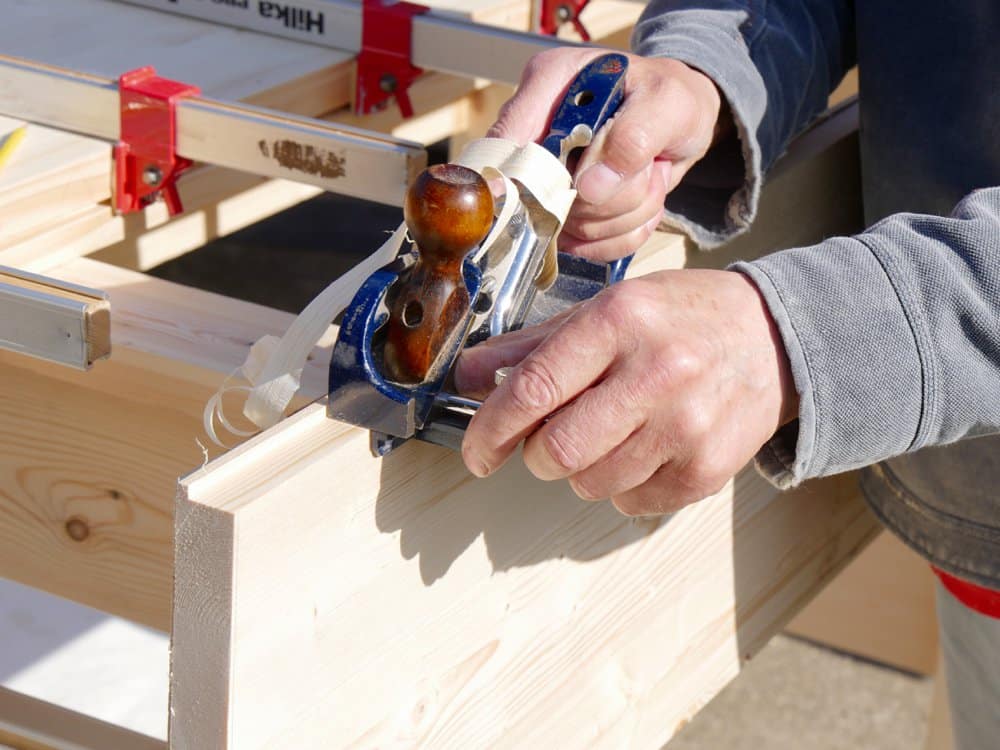
As far as essentiality goes it’s one of those borderline planes I almost included in my latest book Essential Woodworking Hand Tools. It is more versatile than all of the other rebating planes because of its fence and depth guides and its easy setting. You can readily plane end grain as in shoulder lines and such too so don’t think you can’t because you can. If and when you do it’s a good point to sharpen up the blade as this gives pristine results with the least resistance. You can also plane across the face of tenon cheeks too to remove face grain for fitting tenons into mortises and then the bottoms of large and wide housings and dadoes. Very handy. I often use this plane up against and adjacent to the shoulders of tenons on the face grain taking one or two swipes and then completing the outer reaches of the surface of the tenon using my #4 smoothing plane. This is a great combinational use of two very different planes too.
Safe use
As with all of the rebate planes, you must watch for the exposed corners of the cutting iron because they are exposed along the corners of the plane’s sole and will puncture the skin more readily than any other part of plane’s cutting iron; so handle the plane with care. I mention this because we are so used to handling regular bench planes by grabbing the body overhand somewhere either side of the cutting iron area. If we do this with rebate planes we end up claw-clutching the corners of the cutting iron.
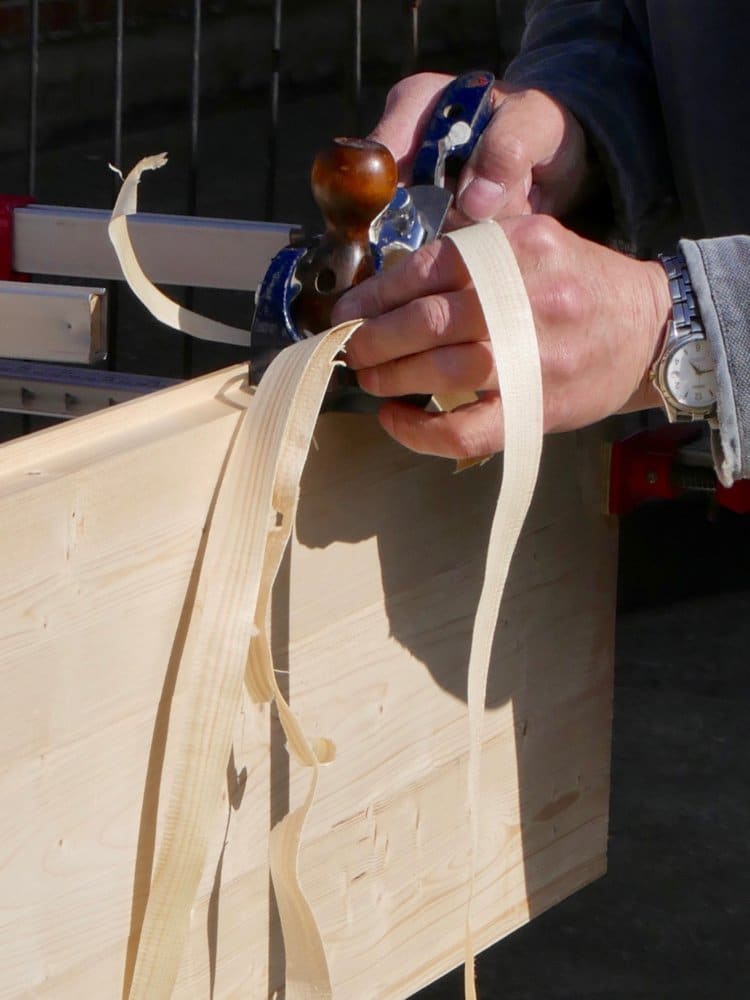
With a heavy (deep) setting the # 78 plane will hog off thick, full length shavings and this is indeed useful for initial cutting and getting quickly down to close depth. Especially is this so with softwoods and less dense-grained woods. Ultimately we want the best surface and this means you should reset to a shallow depth setting for finalising the rebate as this will give a surface finish similar to that achieved with the bench planes.
#78—Its rough-edged appearance
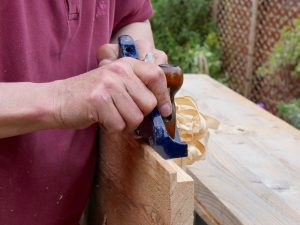
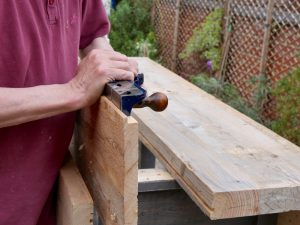
Compared to other rebating planes the # 78 plane is the workhorse in that generally it performs almost all of the tasks the other rebating planes perform but it looks, well, just a bit crude. Don’t let its harsh and less refined appearance fool you, it performs refined cuts very nicely, both with and across the grain and on end grain too. Because of its rough outer character you should not lean towards treating the plane more roughly or indeed fail to work with it to refine it all the more for your working of it. We have covered much of that in the previous blog, but I have met many “diamonds in the rough” through the years that have fooled me with their abilities and ultimate charm. This is definitely one of them. Initialising your particular plane will be your introduction to the ongoing fettling that we must get used to in the day to day working of every plane we have. These opening steps prepare you. They are critical. I can tweak my plane for use, disgorge the throat of clogged shavings and be back in the zone within a few seconds most of the time. This is what makes my life so enriched and this is what makes my work stand out in the day to day of life. For me it is not what you make so much as how you make it. This plane can be an answer for joiners and furniture makers, boat builders, timber framers and several other woodworking trades. Placing it alongside a 1” shoulder plane is not to compare apples with apples, but if you need to start with a plane that does pretty much everything then this is the one to start out with. Add others I will be talking about in this series as you see fit according to need and enjoy working with what you have.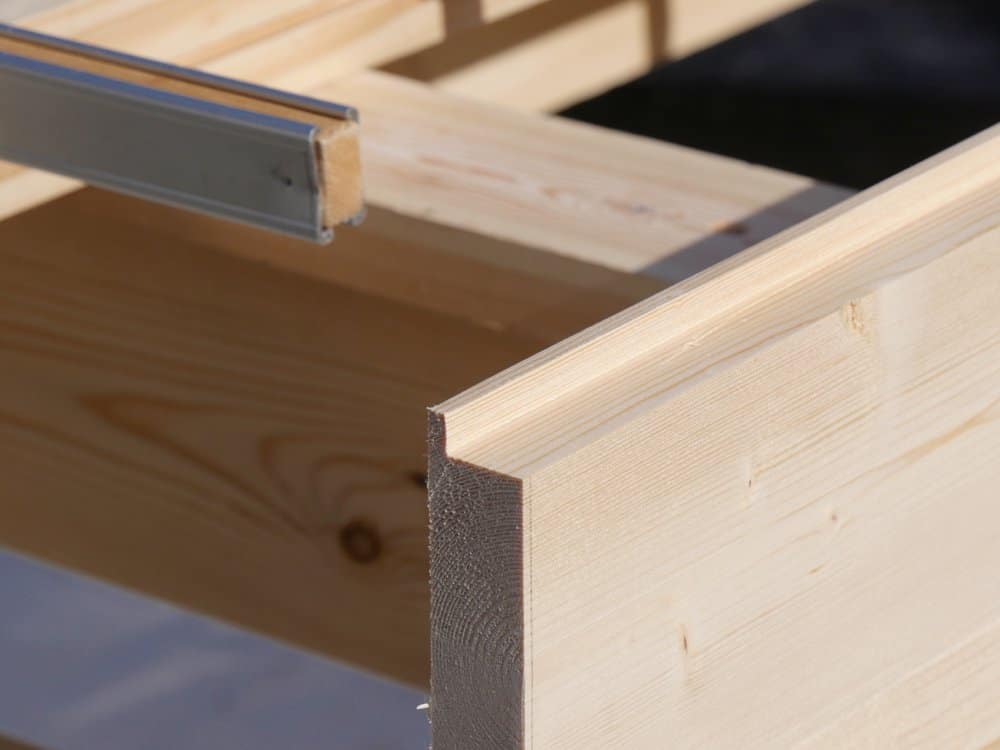
Rebate plane #2 of 10 rebate plane types coming up next!


I’ve found the 78 to be a surprisingly neat plane. Looking at it you’d think it’d only do big chunks, 1/2 inch or so, but it handles smaller, more delicate, rebates without fuss too. Certainly, if not an essential plane, then right next to it.
And thanks Paul, your posts on the plane have saved me a lot of trial and error getting the best out of it. Though I suspect I’ll still catch my hand on the cutter for a while yet, bad habits.
Hey Paul, is the tongue and groove well board a new feature of your workbenches?
Best regards,
Florian
I have done it both ways through the years but the T&G is neater and in some ways simpler too, provided you indeed have a plough plane and rebate plane to work with that is. I have also used T&G boards for this too.
I’ve had mine since about 1966, and it’s had good use in all that time, but I still prefer using my uncle’s (wooden) moving filletster plane.
So glad I purchased my 78 plane when I did. The price will surly sky rocket. All kidding aside. My plane only has the short fence with one guide bar. I was told this is inferior to the double guide bar with the full length fence. Oh well it works.
I think Paul eluded in his first posting on the No.78 to the fact that the single guide bar makes little difference to functionality unles you “dog the plane”. The Record 778 plane has two guide bars and on checking prices on the Bay comparing Stanley and Record I perceive a higher value on average put on the Record plane. I know what I’ll plump for – the cheaper Stanley option. As with most of Paul’s recommendations or endorsements, it does drive up prices as more people all of a sudden want to procure the endorsed. Paul has thousands (if not millions) world wide of “pupils/apprentices” who would all prefer to use what Paul recommends. I’m no different.
Paul,
Thank you for this recommendation. I have started looking for these planes and have yet to find one that looks like the one you are using. None of them have the front knob. Just wondering why they are all so different.
Dan
The front knob was not installed to most of the filletster planes and I don’t find it useful at all, so if you go for a Stanley or Record minus the front knob you will be just fine.
Thanks for your comment about the front knob, I had been wondering why you had not mentioned about it in the blog. I have not seen any #78 fitted with a knob like that and was thinking it was a Paul Sellers addition. I assume the thinking behind fitting the knob was for the same reason as on other planes, but as you say in use it’s not really needed.
I’ve used my #78 plane with no problem all these years without the knob, so I won’t be rushing off to make one now.
In Woden’s (and WS) manuals and marketing, the front knob is for when using the 78 as a smoothing plane. I can’t imagine that the 78 would make a good smoother.
However Paul has a video on converting the 78 to a scrub. I am sure that the knob would be handy for that.
Jack
I’ve got a Record #778 and Paul’s comments about being careful about handling the plane are all too true – as I’ve found out to my cost! It’s just so easy to forget that the blade extends outside the body – and now that I’ve learned how to get a plane blade really sharp …
I have a knockoff version of the #78 (says AMT on the casting) that I just can’t seem to use. I have an issue where the shavings bunch up against the lever cap and fold up into an accordion-shaped clog. I have some photos of the mess but I think you can imagine it. I have taken the lever cap to my grinder and tried to make the angle more acute and not leave anything that would create an obstacle to the shavings but to no avail. Perhaps I should grind off more until it comes to an almost-sharp point? Any advice you could give would be appreciated – I’ve asked other online hand-tool guys but nobody has much advice to give beyond what I have done.
I answer this issue in an upcoming on bullnose planes. It’s almost always caused by too deep a set.
Thank you – I look forward to it.
Just done it Greg.
I do own a #78 although I have yet to use it, it doesn’t have the knob on it and it was a great deal. I will definitely be using this plane more now, thanks Paul.
Steve
I just bought a old rusty Stanly #78 and have put it in working condition after a coup of days trying to get all the rust out of screws and the adjustment lever.
Mine doesn’t have the nice wood knob tote in the front. Does the American version have a different number?
What’s in a name?
http://www.sawmillcreek.org/showthread.php?85602-Rabbet-Fillister Has this to say
“A rabbet is with the grain and a fillester (a.k.a. filletster) is across the grain, similar to the difference between a groove (with the grain) and a dado (across the grain). Both plane types (fenced and unfenced) can be used to make either a rabbet or filletster. Rabbet/fillester planes come in fenced and unfenced varieties, with straight blades or skew blades and with or without scoring irons.” which clearly differentiates (rightly or wrongly)
Hi Paul,
Glad you started this new series because I’m right into troubles with rabbet planes right now. Well, only filletsters actually.
I bought a wooden filletster plane with a skew mouth, hoping it would help me to achieve clean end grain rabbets. I refurbished it, re-squared it, sharpened it, and it tears so much I can’t use it. Probaly a sharpening issue but no matter how I sharpen it, the same, wether I plane end or long grain. So I pulled out my Stanley 78 with a square iron, same tearing on end grain, but a perfect clean cut on long grain.
So I wondered why no XXth century plane makers made an iron skew filletster plane (except for the Stanley #289 which doesn’t seem to have been very popular compared to the standard #78).
I know Veritas has got one in their catalogue now, but how did pre-Veritas craftsmen dealt for example with multiple door panels to make quickly? Did they all use skew wooden filletsters, or special panel-raising planes? Hope you can light me on it!
Regards from France,
Richard
Paul, thank you for this series. Wondering if you could give me a bit more info on setting the depth guage on a rebate plane. Am I correct to assume the depth guage is set to the cutting edge of the iron, not the sole of the plane? Seems to me if I’m hogging out shavings and the depth guage is set to the sole, I could overshoot the depth. I understand we’re talking thousands of an inch…so maybe it’s not an issue?
A few words of wisdom on this would be appreciated!
Thank you,
Phil
Yes, we generally set to the cutting edge and then be prepared to set the depth maybe shallower than the actual intended depth by a fraction so that you can reset for the dead depth you actually want for the final few strokes you take.
Thanks Paul! … and for the quick response.
Phil
Hey Paul,
I’m very excited to get my hands on a Record 778. It cleaned up great and should prove to be very useful. I did find that adjusting the cutter is a little frustrating. When I advance or retract the blade, the cutter tends to shifts a bit out of parallel. Not a huge deal but pretty inconvenient to retest for parallel when you have the fence in place.
Is this a characteristic of the screw type depth adjustment on the 778 or should I be able to correct this with a little more fettling?
It’s worthwhile checking the bed for a bump in the casting to see if this affects the adjustment in the way you are finding it does.
Thanks Paul, I appreciate your time!! I’ll take a close look at that.
small hammer or mallet,always on the bench during my 1950’s apprentieship.FOR gentle loving lateral adjustments – NOT bashing the blade.
Hello Paul!
Thanks for the article. I would like to know your opinion concerning Veritas skew rabbet plane in comparison with Stanley 78.
Skew rabbet planes were developed for good reason but in most work a square rabbet plane will work just fine. Whereas the skew was designed to pull itself into the corner as the cut is effected, what is never mentioned is that it eases the cut and reduces flex that causes the blade to chatter through the cut in certain conditions. A 78 will do work fine.